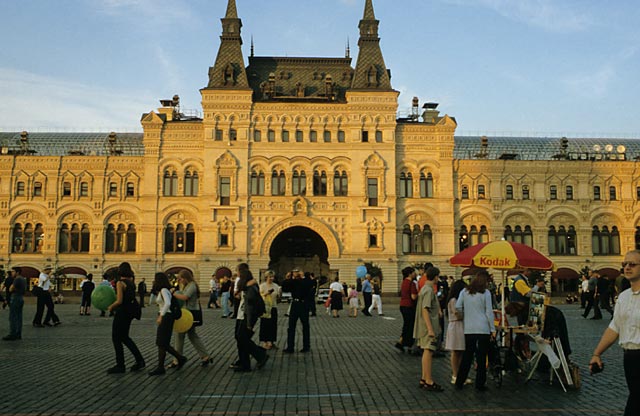
I left home and took an afternoon train from York to London, then a local train to Twickenham. Because of the early flight I needed overnight accommodation fairly close to Heathrow Airport, and my sister Maureen had offered to put me up for the night.
I was up early, and said goodbye to Maureen and the children Jamie (4) and Gemma (1). Richard, my brother-in-law, kindly gave me a lift to Heathrow and on arrival at 7.30 my companions for the journey were already waiting: Bill Bird, Brian Addis, Sandra Dean and Dave Downer. We checked in and had some breakfast at Pret-à-manger before the flight.
The British Airways flight was provided by a Boeing 767, and the 4-hour journey was relieved by a showing of the animated film Chicken Run and a meal of chicken curry. I had seen the film a couple of weeks earlier at the cinema, but it was worth seeing again.
Inside Moscow's Sheremetyevo airport, there was a huge crowd waiting to go through passport control, and it was an hour before we got through. The customs officials were not interested in the currency declaration forms which we had filled in while on the plane. On the arrivals concourse, I spotted my name on a sheet of paper being held up by a young lady, and she introduced herself as Katya and led us to the minibus which took us to the Hotel Ukraina. This hotel is one of the seven 'Stalinesque' buildings in Moscow.
Brian had previously been in touch with his friend Sasha, who lives in Moscow, and we had been invited to his flat for a meal. We met up with Sasha and his son Andrey at the hotel, and then had a white-knuckle high-speed taxi ride to his flat in the Moscow suburbs. It was a very nice flat, and Sasha's wife had prepared a good meal of chicken, fish, cold meats and salad. We also got through two bottles of vodka between us, while listening to Deep Purple CDs. We left at about 2 a.m., in two taxis, at not such high speed, back to the hotel.
 |
The GUM department store in Red Square, Moscow |
We got up fairly late, and had breakfast at 10 o'clock. It was pouring down with rain outside.
The minibus picked us up at 11.30 and took us to Kazanskiy station in Moscow. Sasha was there to see us off, but before leaving we stocked up with 25 bottles of Baltika beer from a stall on the station.
The train to Tashkent, which we would be travelling on for the next three days as far as Bukhara, departed at 12.50, and we were in the front coach. It was in a rather bad state, with many of the interior fittings broken, ceiling panels bent and hanging down, and many of the windows badly fitting. The toilets were, as expected, pretty disgusting. Nevertheless, we soon settled in, and spent the afternoon looking at maps and guidebooks. We tried out the samovar, which supplies hot water, by making cups of soup.
At Michurinsk the train reversed, which meant that for the rest of the journey we would be right at the back of the train. The stop here was long enough for us to walk the length of the train, and we noticed that in the 'hard' class accommodation, some of the windows were actually broken.
Bill, Dave and I decided to visit the restaurant car for a meal. We asked for some beer, but they didn't have any. There didn't appear to be any menu, and the best we could do was to ask for 'dinner' in Russian, and we were brought a rice pilaf with pieces of beef, with a tomato & onion salad and bread. Our presence in the restaurant car caused considerable interest to the few other passengers there. The bill for the meal was 120 roubles in total - we paid in US dollars ($5).
We returned to Brian & Sandra's compartment, and found that they had eaten a similar meal to us, prepared by our sleeping car attendant (provodnik). Lots of people were walking along the corridor selling bread, eggs, sausage, drinks and other things, but we were content to stay in the compartment and drink a few beers.
I slept badly, as it was too hot initially, and my bunk (one of the upper ones) was sloping to the side. There was a lot of noise and knocking on doors when the train stopped at Saratov, then I had to get up to visit the toilet, and later in the night it became too cold.
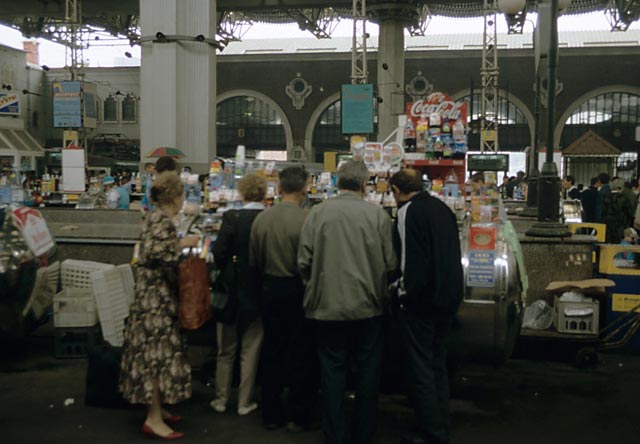 |
Kazanskiy Station, Moscow |
I had a cup of hot chocolate and a Nutri-grain bar for breakfast. Outside was flat, featureless grassland. During the morning, the train was running southwards close to the Russian/Kazak border, twice crossing into Kazakstan and then back into Russia, but without any border formalities.
At Verkhniy Baskunchak we walked to the front of the train to observe the locomotive change. Here, the platform was packed with people selling all sorts of food, but particularly melons. There was also a stack of car tyres. Sandra bought some onion doughnuts, which were very tasty.
After leaving Verkhniy Baskunchak we had a sort of 'conversation' with a Russian deaf mute man, using sign language and pointing out words in a Russian/English dictionary. He was a mechanic and was travelling to Astrakhan. On this section of the journey the Russian exit border control was carried out, and the border guard asked us into the provodnik's compartment, where he did his paperwork, checking up in his book before stamping our passport and visa.
There was a long stop at Aksarayskaya, the last station in Russia, where we bought an ice cream on the platform. The train left a few minutes early, pulling away slowly to allow people time to scramble back on before it gathered speed.
In the early evening the restaurant car attendant came along the train touting for business, and offered to bring us 'plov' (pilaf) to the compartment, and we took up this offer. Bill gave him $7 for the meal. The provodnik in our own carriage said that was too much and he would make us a meal for less the following evening.
We crossed the border into Kazakstan and stopped at Ganyushkino, near the north shore of the Caspian Sea. The light was failing, but Bill was taking photographs using his long lens, which attracted the attention of a station official. He was 'rescued' by one of our provodniks, but the station official followed us back into the compartment and asked to see Bill's camera. We acted dumb, and showed him Dave's much cheaper camera, and he eventually left us alone.
A lot of stuff was brought onto the train during the day, particularly bottles of beer by our provodniks, and car tyres which were stacked up as high as the ceiling in the rear vestibule of our coach.
I slept fairly well, with just a few interruptions at station stops.
 |
Verkhniy Baskunchak station |
I got up while the train was stopped at Beyneu, the last station in Kazakstan. After departure I opened the compartment door and found that the corridor was full of people camped out with all their luggage. Later in the morning one of our provodniks ushered them further along the corridor so that we could have unobstructed access to the samovar and toilet at the end of the corridor, obviously treating us as Very Important Passengers.
Outside, the landscape was flat, with only tufts of brownish grass growing in the sandy soil. We spotted quite a few camels.
After crossing the border and entering Uzbekistan, we stopped at Karakalpakiya station for an hour rather than the booked 3 minutes, although there was no passport check on either side of the border. While we were here, we saw the Dushanbe (Tajikistan) to Moscow train depart. It looked even tattier than our train, and there were a number of people riding on the roof.
We had a late breakfast consisting of a cup of soup, some chocolate Hob-nobs and a glass of tea in Brian & Sandra's compartment.
At Zhaslik station we bought two circular pieces of 'non' (bread) for 5 roubles each, a bottle of water for 10 roubles and a bag of salad vegetables for 5 roubles. We had not yet got any Uzbek currency, but the locals on the station were quite happy to accept Russian roubles, which gave us an opportunity to spend some of our unused cash. We ate the food for lunch, together with some cheese and beer.
As the train approached Qongirat the train passed through an area of dried-up lakes with salt deposits, the result of massive irrigation schemes elsewhere in Uzbekistan which have deprived this area of its natural water supply and caused ecological devastation. The train went round a number of bends here (most of the route is very straight) and this enabled us to see that there were people on the roof of our train.
At Qongirat (Kungrad in Russian) there seemed to be almost as many people on the platform selling things, as there were on the train. Many were selling smoked fish, possibly snake-fish. I didn't buy one on the station, but when people came walking along the train selling them I decided to buy one, which cost 10 roubles. We spent the next hour or so hacking it to pieces and eating it.
The sun had been shining strongly all day, though a few clouds appeared by late afternoon. The temperature in the train became uncomfortably hot, especially when the train stopped.
We made our next border crossing, the seventh of ten we would make on this train, in the early evening, and stopped at Takhiatash in Turkmenistan. Here, a representative from a local travel company, Ayan, joined us to help in case of any problems with our passports or lack of visas, but in the event there were no problems, and he left at the next station which was his home town, Dashoguz (also known as Tashauz). On the platform at Dashoguz, there were a couple of stalls cooking and selling shashlyk (kebab on a skewer), but we decided it might be wise to avoid these.
Later in the evening, the train re-entered Uzbekistan to call at Urgench station, then crossed back into Turkmenistan.
 |
The smoked fish bought on the train after leaving Qongirat |
We were awoken by a knock on the compartment door, at about 7 o'clock. We were at Farap, the last station in Turkmenistan before the Uzbek border, and it was a customs official who wanted to see our currency declaration forms. We produced the ones we had filled in on the flight to Moscow, which were the only ones we had, as nobody had bothered with them at any of the other borders we had crossed on this train. He didn't seem worried about the fact that they were for entry to Russia rather than Turkmenistan, but he did not like the fact that they hadn't been stamped. We explained that we had tried to get them stamped but were told it wasn't necessary. Eventually he gave up and left us.
After leaving Farap, the landscape was still desert-like, but not flat, like small sand dunes. The first station in Uzbekistan was Khodzhadavlet, and here our Uzbek visas were inspected and stamped. We asked about currency declaration forms, thinking that getting one here and getting it stamped may prevent problems when we leave Uzbekistan in a week's time. We were told to get them on arrival at Bukhara.
We arrived at our destination of Bukhara an hour late, at about 11.30. At the station exit, officials were checking passports of all passengers who had left the train, which was quite a slow process. We had spotted our 'guide' on the other side of the gates, and when we were through he introduced himself as Farkhad and explained that he ran the guest house where we were staying. We told him we wanted to get currency declaration forms sorted out, so he took us to a police office, from where we were eventually redirected to a customs office on the station. Here we were given the forms, which we duly filled in and returned. We were then called in to the customs examination area one at a time, and the three customs officials wanted to go through all our luggage, taking particular interest in how much money we had and any valuable equipment (in my case they even wanted to know what CDs I had). We were grateful to have Farkhad to act as interpreter for the many questions they asked, though it must be said that they were very good-humoured about it all. In Dave's case they took particular interest in his copy of FHM magazine, and Bill really fazed them by having two British passports. It was about 2 o'clock by the time we got away.
We were taken by minibus to the guest house where we would be spending the next three nights. Known as 'Farkhad & Maya's', it was in the maze of narrow alleyways which form the old town in Bukhara. From the outside it appeared as an anonymous door in the wall, but inside was a pleasant courtyard with rooms around the side. The rooms were comfortable, and decorated with colourful carpets hung on the walls. We changed $100 into the local currency (sum), and received a carrier bag full of large wads of notes. There was a young English couple also staying here, who had travelled from Cairo to Kashgar and were now on their way back.
After a shower and a siesta (the temperature reached about 40C during the afternoon) we went for a short walk. As we walked through the narrow walled streets, children would run up to us and shout "Hello, mister! What is your name? Pen? Bon-bon?" We continued via the Gaukushan Medressa to the Labi-hauz area where there are a group of medressas (Islamic colleges) arranged around a central pool.
We returned to the guest house for dinner, which we ate in the open air in the courtyard. The meal consisted of meat & vegetable soup followed by stuffed peppers, then watermelon and tea to finish. We were glad to have an early night and sleep in proper beds.
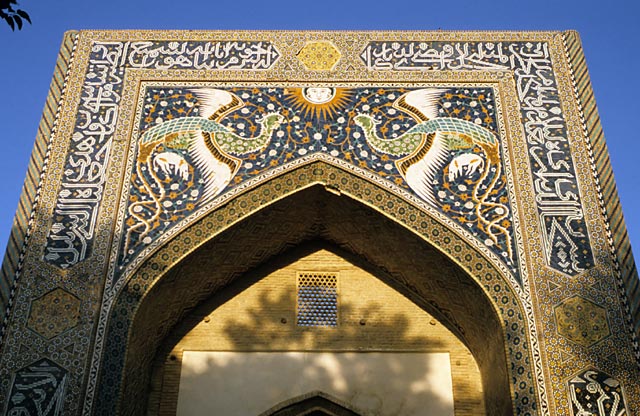 |
Facade of the Nadir Divanbegi Medressa, Bukhara |
Breakfast, again eaten outside, was pancakes with jam, a yogurt drink and tea.
In the morning, we walked to the large fort known as the Ark. There are a number of buildings within the walls, many of them housing museums. We spent much of the morning here, then went across the road to a teahouse, where we sat in the shade of trees, out of the powerful sun. We had a quick look at a nearby mosque, then went up to the top of an old water tower which has been converted to a viewing platform. The top is reached by a rickety old lift, operated by a rickety old man, but once there we had a good view of the Ark and the rest of the town.
By one o'clock it was getting uncomfortably hot, so we walked back to the guesthouse where we could drink more tea, eat melon and sit in the shade (or even sleep).
Later in the afternoon we ventured out again, this time to the Kalon mosque and minaret. We climbed to the top of the minaret for another aerial view of the town, and then lingered in the square as the sun went down. The square also contains the Mir-i-Arab Medressa, a former Islamic college, with its two blue-tiled domes which looked very attractive in the setting sun.
We ate at the guesthouse again in the evening, as there aren't any restaurants in Bukhara other then hotel restaurants. Tonight we had a sort of spring roll as starter (with lots of garlic), then a lamb casserole, and finished off with melon and tea.
The guesthouse provides free e-mail facilities to guests so we used the computer to send a couple of messages home before retiring for the night.
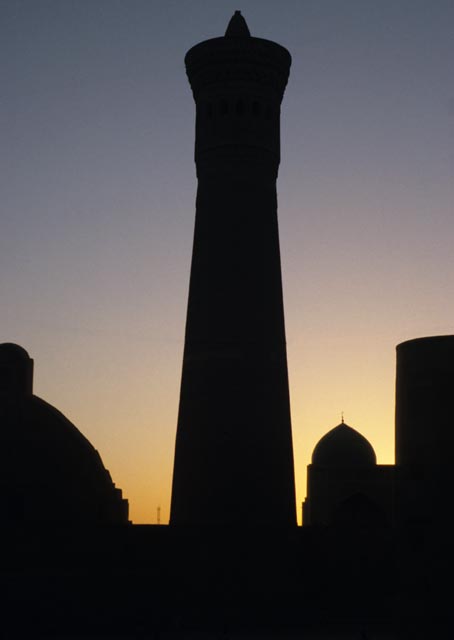 |
The Kalon minaret |
We got up early to walk to the Kalon mosque area before breakfast, so that we could photograph it in the morning light and without all the various souvenir and snack stalls which fill the square later in the day. We also tried to walk to the Char Minar, a distinctive blue-domed building, but set off in the wrong direction, so we gave up and decided to visit it later in the day.
Breakfast, at 8 o'clock, today was semolina with jam, followed by fried egg, cheese and bread.
This morning, Farkhad offered to show us round some sights in Bukhara that we might not otherwise see. We started off by walking to an old merchant's house. As well as looking round the house, which was very ornately decorated outside and in, Brian and Sandra volunteered to dress up in traditional costume. Although the costume was very colourful, it was undoubtedly very hot underneath.
Farkhad then organised two taxis to take us to the Summer Palace just outside the town. Our taxi driver called at his house on the way to pick up his spare can of fuel. After a walk around the Summer Palace, we travelled by minibus-taxi to the 'Holy Place'. These minibus-taxis offer frequent communal transport along specified routes for a fixed fare, and appear to be the main means of transport for most of the local population. There would appear to be no minimum requirements for the standard of driving or the condition of the vehicles.
We returned to the guesthouse in the early afternoon, again by minibus-taxi. We were supplied with melon for lunch, and then had our customary afternoon siesta.
Later, we walked to the Char Minar, and found it this time. We walked back via the War Memorial, which with its Soviet-era monument and large open square, and music coming from tinny loudspeakers, contrasted starkly with the rest of the town. The most direct way back from here was through the narrow residential streets, so we set off in what was probably the right direction, but the twists and turns threw us off course and we found ourselves emerging near Labi-hauz. At least we knew our way back from there.
Dinner tonight was a pilaff with salad, followed by the usual melon and tea.
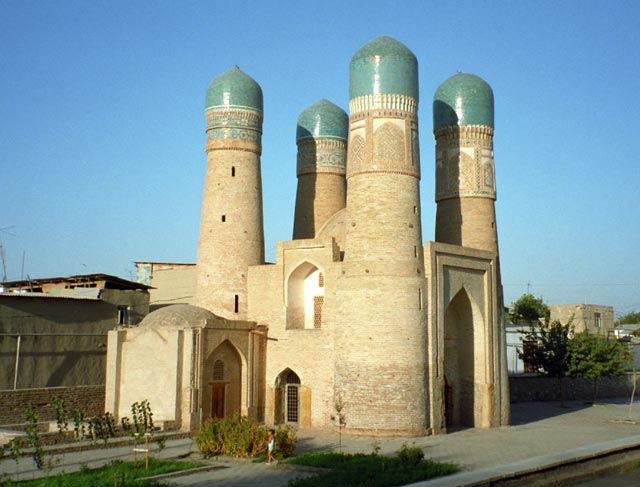 |
Char Minar |
 |
|